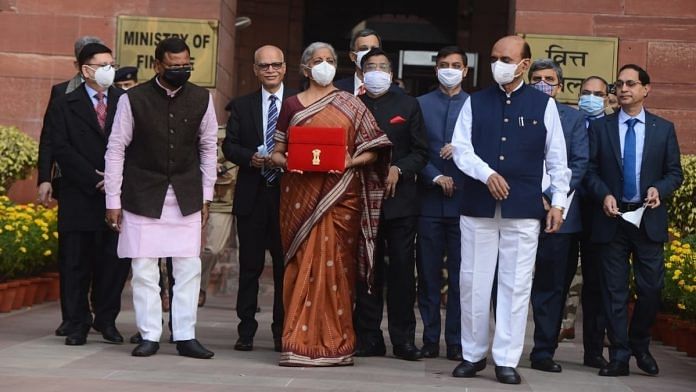In 1995, economist Robert Lucas was awarded the Nobel Prize in economics for his seminal work in 1976 postulating that textbook macroeconomic hypothesis based on certain a priori behavioural assumptions of agents could change because of shift in agent’s behavior in uncertain times. Interestingly, 1970s was one of the most disruptive periods in economics, with inflation and unemployment in the US peaking. This is in contrast with what is happening currently across the globe with the pandemic wreaking havoc in terms of invalidating inferences based on interlinkage between past data and future policy making. In India too, there has been a fundamental shift in the behaviour of economic agents post-pandemic, that include individuals as well as institutions — significant perk up in lending to MSMEs, a surge in retail participation in financial markets, increased recourse to digital platform and a startup revolution, to name a few. This year’s Budget seeks to put a stamp of approval for such behavioural changes.
But first, let us get the most pressing question out of the way.
The common man, much fabled creation of R.K. Laxman since the early 50s, has epitomised the ambitions, optimisms, dilemmas and even idiosyncrasies of the average Indian in the past. For the common man, a Budget is always an opportunity to expect tax concessions. But there are both ‘for’ and ‘against’ arguments for such expectations.
Also read: Why Nirmala Sitharaman’s Budget 2022 is, and isn’t, an election Budget
Common man’s expectations
India’s per capita GDP in FY21 stood at Rs 1.46 lakh while the taxable income threshold is Rs 2.5 lakh. This shows that the average Indian is not required to pay an income tax and that is weird by any economic logic. In most countries, the income tax limit is below the average income of its people. Only India and Bangladesh are exceptions.
But what is also true is that in some countries, including India, the top marginal personal income tax rate exceeds the corporate income tax by a significant margin, providing strong incentives for taxpayers to choose the corporate form of doing business rather than being an individual tax payer for purely tax reasons. This provides a clear bias for entrepreneurs to escape the highest personal income tax permanently.
Given this dichotomy, the finance minister has done the best she could have under the current economic environment — ensured the stability of the taxation regime and maintained continuity and momentum in vision.
Also read: Digital India is Modi govt’s priority. Budget gives it a push — from manufacturing to infra
Accepting new realities of economy
Coming back to the changes in the Budget that seek to carry forward the behavioural changes in India’s economy. The impetus to the MSME sector deserves special mention. There is always a large overlap between the common man and the MSME sector. Employing over 11 crore workers, MSMEs contribute to 29 per cent of India’s GDP. The Emergency Credit Line Guarantee (ECLG) scheme was a huge success and in FY21, India disbursed loans worth Rs 9.5 lakh crore to the MSME sector, a staggering jump of 40 per cent over FY20 credit levels, covering more than 130 lakh units. The extension of ECLG scheme coupled with changes in the current credit guarantee product for SME sector/CGTMSE (Credit Guarantee Fund Trust for Micro and Small Enterprises) are sure enablers for a continued credit growth to the SME sector. We expect that the revamped credit guarantee scheme, CGTMSE, could provide a Rs 2 lakh crore bonanza for the sector, supporting 6.25 lakh units employing over 1.25 crore people.
The Budget also seeks to turbo charge the vast swathe of rural population by proposing to link the 1.5 lakh post offices with the core banking system of the lenders. It proposes to set up 75 Digital Banking Units (DBUs) in 75 districts by Scheduled Commercial Banks (SCBs). This proposal is in sync with the ongoing digital banking initiatives, and clearly dovetails with the vision of ‘One India @ 2047’ and transitioning to a Banking 4.0 model that combines technology to provide banking as a service.
The most significant announcement of the Budget could be the proposed introduction of Central Bank Digital Currency (CBDC) that should give a huge boost to India’s digital economy on all fronts, from retail payments to cross-border transactions to payments and settlements for MSMEs to Direct Benefits Transfers. Such mechanism will make digital currencies more accessible to the people, just as UPI made digital cash easier to use.
The Budget also provides a digital thrust to the National Digital Health Mission, which will receive a total of Rs 200 crore in the coming fiscal, as compared to only Rs 75 crore in FY22. For an education sector that has been ravaged by the pandemic, establishing a Digital University and dedicating over 200 channels covering multiple regional languages under the ‘One Class-One Channel’ scheme are innovative initiatives.
The common man will also be enthused with the proposal in the Budget of the supposed linkage of National Generic Document Registration System (NGDRS) with the ‘One-Nation One-Registration Software’ for uniform process for registration and ‘anywhere registration’ of deeds and documents.
The critics can argue that the allocation for the Ministry of Rural Development has increased by only 3.4 per cent over FY22 estimates and the Budget has allocated only Rs 73,000 crore for the rural jobs guarantee programme MGNREGA for FY23, 25.5 per cent lower than the revised estimate for the current fiscal. But comparing figures with a pandemic year will always show up these statistical artefacts. It is only a matter of time before the strong emphasis on capital expenditure in the Budget will crowd in private investment. This as it happens will benefit the common man through larger employment rather than doles.
Soumya Kanti Ghosh is Group Chief Economic Advisor, State Bank of India. Views are personal.
(Edited by Anurag Chaubey)



